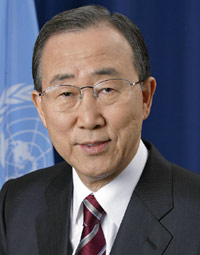
United Nations Secretary-General Ban Ki-Moon.
A United Nations field report about the Aug. 21 chemical weapons assault in Syria suggests a more limited area of attack than an earlier U.S. government report claimed, and reveals that some inspected sites showed signs of possible manipulation of evidence.
Though the mainstream U.S. news media and some non-governmental organizations highlighted the UN findings that tended to bolster the U.S. government's case against the Syrian government, a close reading of the 38-page report reveals contradictions to that conclusion.
By contrast, tests for Sarin were more clearly positive from samples taken two and three days later -- on Aug. 28-29 -- in the eastern suburban area of Zamalka/Ein Tarma. There, Lab One found Sarin in 11 of 17 samples and Lab Two found Sarin in all 17 samples.
Though the UN report concludes that Sarin was present in Moadamiyah -- despite the failure to identify actual chemical-warfare agents -- the report does not explain why the Aug. 26 samples in Moadamiyah would test so negatively when the Aug. 28-29 samples in Zamalka/Ein Tarma would test much more positively.
One would have thought that the earlier samples would test more strongly than later samples after two or three more days of exposure to sun and other elements. An obvious explanation would be that the release of Sarin was concentrated in the eastern suburb and that the spotty residue detected in the south came from other factors, such as false positives for secondary chemicals especially from Lab Two.
If the Aug. 21 attack centered on Zamalka/Ein Tarma as the UN results suggest, that could indicate a much less expansive use of chemical weapons than a U.S. government white paper claimed. The alleged breadth of the attack served as a primary argument for blaming the Syrian government given its greater military capabilities than the rebels.
That point was driven home by President Barack Obama in his nationally televised address on Sept. 10 when he asserted that 11 neighborhoods had come under chemical bombardment on Aug. 21. [See Consortiumnews.com's "Obama Still Withholds Syria Evidence."]
However, even the U.S. "Government Assessment" on the attack, issued on Aug. 30, suggested that the initial reports of about a dozen targets around Damascus may have been exaggerated. A footnote contained in a White House-released map of the supposed locations of the attack read:
"Reports of chemical attacks originating from some locations may reflect the movement of patients exposed in one neighborhood to field hospitals and medical facilities in the surrounding area. They may also reflect confusion and panic triggered by the ongoing artillery and rocket barrage, and reports of chemical use in other neighborhoods."
In other words, victims from one location could have rushed to clinics in other neighborhoods, creating the impression of a more widespread attack than actually occurred. That possibility would seem to be underscored by the divergent findings of the UN inspectors when they took soil and other environmental samples from the southern and eastern areas and got strikingly different results.
Reliant on Rebels
The UN inspectors also revealed how dependent they were on Syrian rebels for access to the areas of the alleged chemical attacks and to witnesses, with one rebel commander even asked to take "custody" of the UN inspection.
"An elaborate information exchange took place between UNOJSR [the UN team] and key representatives of the opposition. The information gathered through these exchanges would be used to formulate an action plan for the upcoming visit, which became very critical to the success of the mission," the UN report said...
"A leader of the local opposition forces who was deemed prominent in the area to be visited by the Mission, was identified and requested to take 'custody' of the Mission. The point of contact within the opposition was used to ensure the security and movement of the Mission, to facilitate the access to the most critical cases/witnesses to be interviewed and sampled by the Mission and to control patients and crowd in order for the Mission to focus on its main activities."
While at the suspected attack sites, the inspectors also detected signs that evidence had apparently been "moved" and "possibly manipulated." Regarding the Moadamiyah area, the UN reported noted, "Fragments [of rockets] and other possible evidence have clearly been handled/moved prior to the arrival of the investigative team."
In the Zamalka/Ein Tarma neighborhood, where a crudely made missile apparently delivered the poison gas, the inspectors stated that "the locations have been well traveled by other individuals prior to the arrival of the Mission. " During the time spent at these locations, individuals arrived carrying other suspected munitions indicating that such potential evidence is being moved and possibly manipulated."
The UN inspectors did not draw any conclusion from their research as to whether Syrian government forces or the rebels were responsible for the hundreds of civilian deaths that resulted from the apparent use of Sarin gas. However, major U.S. news outlets, including the New York Times and the Washington Post, concluded that the findings implicated the Syrian government.
Those accounts cited weapons "experts" as asserting that the type of missiles used and the supposed sophistication of the Sarin were beyond the known capabilities of the rebels. The articles also said the rough calculations by the UN inspectors of the likely missile trajectories suggested that the launches occurred in government-controlled areas with the missiles landing in areas where the rebels dominate.
(Note: You can view every article as one long page if you sign up as an Advocate Member, or higher).





